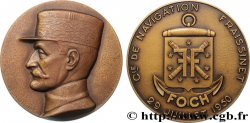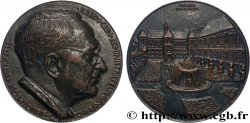Live auction - fme_906363 - IV REPUBLIC Médaille, Académie de médecine, Service de la Tuberculose
You must signin and be an approved bidder to bid, LOGIN TO BID. Accounts are subject to approval and the approval process takes place within 48 hours. Do not wait until the day a sale closes to register. Clicking on "BID" constitutes acceptance of the terms of use of cgb.fr private live auctions.
Bids must be placed in whole Euro amounts only. The sale will start closing at the time stated on the item description; any bids received at the site after the closing time will not be executed. Transmission times may vary and bids could be rejected if you wait until the last second. For further information check the Live auction FAQ
All winning bids are subject to a 18% buyer’s fee.
All winning bids are subject to a 18% buyer’s fee.
| Estimate : | 120 € |
| Price : | no bid |
| Maximum bid : | no bid |
| End of the sale : | 09 April 2024 18:21:03 |
Type : Médaille, Académie de médecine, Service de la Tuberculose
Date: 1956
Mint name / Town : 75 - Paris
Metal : bronze
Diameter : 59 mm
Orientation dies : 12 h.
Engraver PATEY Henri-Auguste-Jules (1855-1930)
Weight : 92,15 g.
Edge : lisse + Corne BRONZE
Puncheon : corne BRONZE
Coments on the condition:
Patine hétérogène. Quelques points d’usure
Obverse
Obverse legend : ACADÉMIE DE MÉDECINE.
Obverse description : Trois femmes autour d’une table ; à l’exergue portrait d’Esculape dans un médaillon posé sur un tronc avec deux serpents enroulés. Signé : A. PATEY.
Reverse
Reverse legend : SERVICE DE LA / TUBERCULOSE // M. LE DR AUPETIT / 1956.
Reverse description : Vue architecturale de l’Académie avec un cartouche pisé sur une gerbe végétale retenue par un ruban inscrit.
Commentary
Médaille, conservée dans une boîte cartonnée bordeaux, décernée au docteur Aupetit.
Dans la mythologie grecque, Asclépios (en latin Aesculapius) est dans l'épopée homérique un héros thessalien puis, à l'époque classique, le dieu gréco-romain de la médecine. Fils d'Apollon, il meurt foudroyé par Zeus pour avoir ressuscité les morts, avant d'être placé dans le ciel sous la forme de la constellation du Serpentaire.
Il correspond à l'Esculape romain, dont le nom est une traduction en alphabet latin du dieu grec, et à l'Imhotep égyptien. Son attribut principal est le bâton d'Asclépios, autour duquel s'enroule un serpent, aujourd'hui symbole de la médecine.
Son principal lieu de culte est situé à Épidaure, où il guérit les pèlerins par incubation. Il est invoqué dans le serment d'Hippocrate aux côtés de son père Apollon et de ses filles principales Hygie et Panacée. Il est l'ancêtre mythique des Asclépiades, une dynastie de médecins exerçant à Cos et Cnide, dont Hippocrate est le plus illustre membre..
Medal, preserved in a burgundy cardboard box, awarded to Doctor Aupetit. In Greek mythology, Asclepius (in Latin Aesculapius) is a Thessalian hero in the Homeric epic and then, in the classical period, the Greco-Roman god of medicine. Son of Apollo, he died struck down by Zeus for having resurrected the dead, before being placed in the sky in the form of the constellation Serpentarius. He corresponds to the Roman Aesculapius, whose name is a translation into the Latin alphabet of the Greek god, and to the Egyptian Imhotep. His main attribute is the staff of Asclepius, around which a serpent is coiled, today a symbol of medicine. His main place of worship is located at Epidaurus, where he heals pilgrims by incubation. He is invoked in the Hippocratic Oath alongside his father Apollo and his main daughters Hygieia and Panacea. He is the mythical ancestor of the Asclepiades, a dynasty of physicians practicing in Cos and Cnidus, of which Hippocrates is the most illustrious member.
Dans la mythologie grecque, Asclépios (en latin Aesculapius) est dans l'épopée homérique un héros thessalien puis, à l'époque classique, le dieu gréco-romain de la médecine. Fils d'Apollon, il meurt foudroyé par Zeus pour avoir ressuscité les morts, avant d'être placé dans le ciel sous la forme de la constellation du Serpentaire.
Il correspond à l'Esculape romain, dont le nom est une traduction en alphabet latin du dieu grec, et à l'Imhotep égyptien. Son attribut principal est le bâton d'Asclépios, autour duquel s'enroule un serpent, aujourd'hui symbole de la médecine.
Son principal lieu de culte est situé à Épidaure, où il guérit les pèlerins par incubation. Il est invoqué dans le serment d'Hippocrate aux côtés de son père Apollon et de ses filles principales Hygie et Panacée. Il est l'ancêtre mythique des Asclépiades, une dynastie de médecins exerçant à Cos et Cnide, dont Hippocrate est le plus illustre membre..
Medal, preserved in a burgundy cardboard box, awarded to Doctor Aupetit. In Greek mythology, Asclepius (in Latin Aesculapius) is a Thessalian hero in the Homeric epic and then, in the classical period, the Greco-Roman god of medicine. Son of Apollo, he died struck down by Zeus for having resurrected the dead, before being placed in the sky in the form of the constellation Serpentarius. He corresponds to the Roman Aesculapius, whose name is a translation into the Latin alphabet of the Greek god, and to the Egyptian Imhotep. His main attribute is the staff of Asclepius, around which a serpent is coiled, today a symbol of medicine. His main place of worship is located at Epidaurus, where he heals pilgrims by incubation. He is invoked in the Hippocratic Oath alongside his father Apollo and his main daughters Hygieia and Panacea. He is the mythical ancestor of the Asclepiades, a dynasty of physicians practicing in Cos and Cnidus, of which Hippocrates is the most illustrious member.








 Report a mistake
Report a mistake Print the page
Print the page Share my selection
Share my selection Ask a question
Ask a question Consign / sell
Consign / sell
 Full data
Full data









